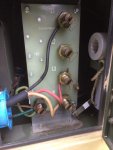fastbrass
Member
- 30
- 0
- 6
- Location
- Detroit, MI
I know hookups and wiring have been covered extensively, but after a couple hours of searching, I'm still lost! Maybe I need to learn how to internet better.
I recently acquired an 802a and ordered a 240v 3000/5000w space heater for load testing.
The heater has a three prong plug, like a house dryer. line/line/ground .. right? A few other items have this same setup, our 240v air compressor being one of them.
To to wire this heater for load testing, what terminal lugs do I use for the three wires in the heater? L1, L3, and Ground, or L1, L3, and N ?
I do have the bonding plate installed, which means Ground and Neutral are one-in-the-same, right? So it wouldn't matter?
Eventually this will be home-backup and I'll work with an electrician to get it done right, but for right now, I want to load-test and do maintenance.
Thanks! And of course if this particular situation has already been answered, I'm glad to be pointed in the right direction.
I recently acquired an 802a and ordered a 240v 3000/5000w space heater for load testing.
The heater has a three prong plug, like a house dryer. line/line/ground .. right? A few other items have this same setup, our 240v air compressor being one of them.
To to wire this heater for load testing, what terminal lugs do I use for the three wires in the heater? L1, L3, and Ground, or L1, L3, and N ?
I do have the bonding plate installed, which means Ground and Neutral are one-in-the-same, right? So it wouldn't matter?
Eventually this will be home-backup and I'll work with an electrician to get it done right, but for right now, I want to load-test and do maintenance.
Thanks! And of course if this particular situation has already been answered, I'm glad to be pointed in the right direction.



